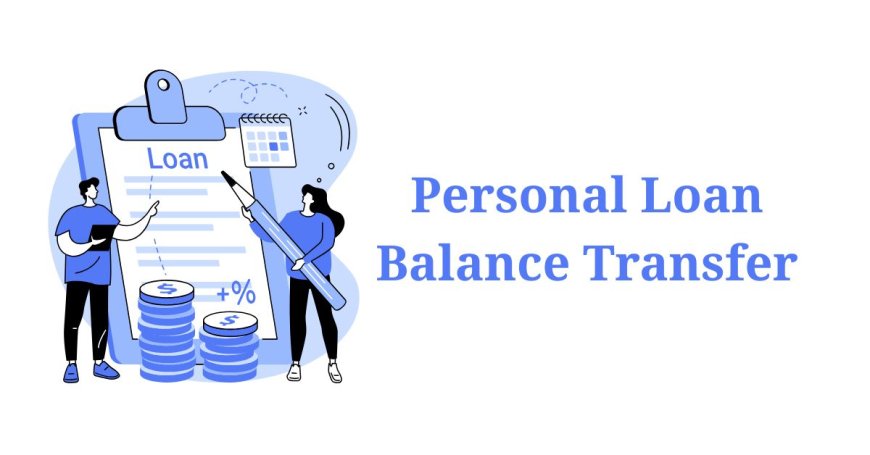Personal Loan Transfer Explained for Beginners

Managing your finances can feel overwhelming, especially when you’re dealing with loans. If you already have a personal loan but are struggling with high interest rates or unfavorable terms, a personal loan transfer might be a smart solution. For beginners, this concept might seem confusing—but don’t worry. This guide will walk you through everything you need to know about personal loan transfers, why people choose them, and how you can benefit.
What Is a Personal Loan Transfer?
A personal loan transfer, also known as loan balance transfer, involves shifting your existing personal loan from one lender to another. The goal is usually to secure better interest rates, lower monthly EMIs, or more favorable loan terms.
When you transfer your loan, the new lender pays off your outstanding balance to the old lender. You, in turn, continue repaying the loan to the new lender, usually under revised terms that work better for your financial situation.
Why Consider a Personal Loan Transfer?
Here are some of the most common reasons why borrowers choose to transfer their personal loans:
1. Lower Interest Rates
Interest rates have a significant impact on your total repayment amount. If another bank offers a lower interest rate than your current lender, transferring your loan can help you save money over the loan tenure.
2. Reduced EMI Burden
With a lower interest rate or longer repayment period, your EMIs (Equated Monthly Installments) could become more manageable, easing your monthly financial load.
3. Better Loan Features
New lenders might offer added benefits like zero prepayment charges, top-up loans, or flexible repayment options that weren't available in your original loan agreement.
4. Improved Customer Service
If you’re unhappy with your current lender’s customer service or digital facilities, switching to a more customer-friendly bank can improve your overall borrowing experience.
When Is the Right Time to Transfer a Personal Loan?
Not every situation calls for a loan transfer. Here are a few indicators that it might be the right time:
- You’ve repaid a significant portion of your loan (usually after the first 6–12 months).
- Your credit score has improved, allowing you to qualify for better offers.
- Interest rates in the market have dropped since you first took the loan.
- You need better loan terms, like longer tenure or flexible repayment.
Eligibility Criteria for Loan Transfer
Each lender has its own criteria, but most commonly, you’ll need:
- A good credit score (usually 700 or above)
- Regular EMI payment history with your current loan
- A minimum loan repayment period completed (often 6–12 months)
- Proof of stable income or employment
Documents Required
Here’s a list of documents typically needed for a personal loan balance transfer:
- Identity proof (Aadhaar, PAN card, etc.)
- Address proof
- Last 3–6 months’ bank statements
- Salary slips or income proof
- Loan agreement from your current lender
- Statement of outstanding loan balance
Steps to Transfer a Personal Loan
Here’s a step-by-step process to transfer your personal loan:
1. Research and Compare Lenders
Start by comparing offers from different banks or NBFCs. Look at interest rates, processing fees, tenure options, and customer reviews.
2. Check Eligibility
Use online eligibility calculators or contact the new lender directly to check if you qualify for a loan transfer.
3. Apply for Transfer
Once you choose a lender, submit your application along with the required documents.
4. Get a NOC from Existing Lender
Your current lender will issue a No Objection Certificate (NOC) and a loan foreclosure letter.
5. New Lender Pays Old Loan
Your new lender will pay off the outstanding amount to your current lender. Your old loan account will be closed.
6. Start Repaying to the New Lender
You’ll begin making monthly EMIs to the new lender based on the new loan terms.
Things to Consider Before Transferring
Before you go ahead with the transfer, keep the following in mind:
- Processing fees and foreclosure charges might apply.
- Ensure the savings from lower interest rates outweigh the charges involved in transferring the loan.
- Read the terms and conditions of the new loan carefully.
- Don’t transfer if you’re nearing the end of your repayment period—savings might be minimal.
Final Thoughts
A personal loan transfer can be a smart financial move if done for the right reasons. It allows you to lower your interest burden, get better repayment terms, and improve your overall financial flexibility. However, like any financial decision, it requires careful consideration, proper research, and a clear understanding of your financial goals.



































